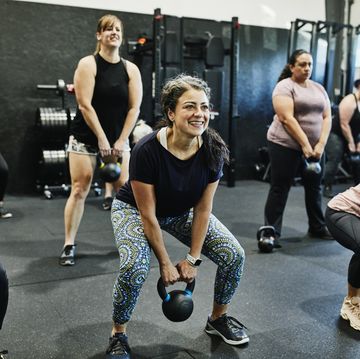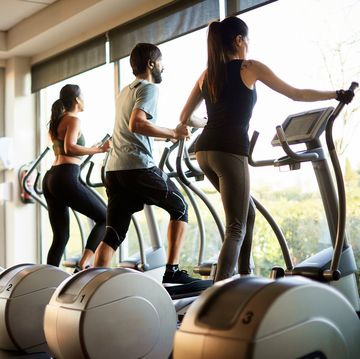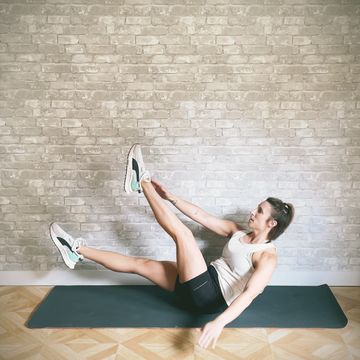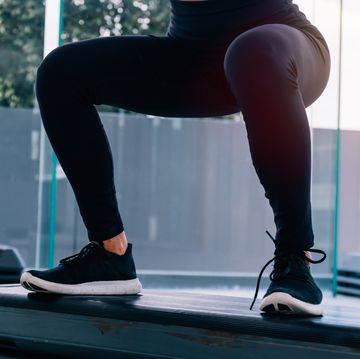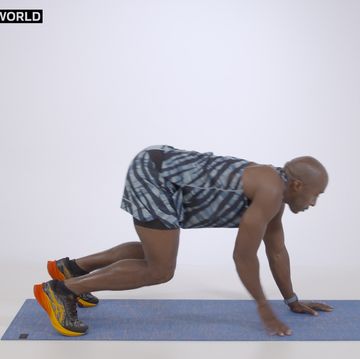After John Korir won the 2025 Boston Marathon in 2:04:45, runners flocked to his Instagram to learn more about his training. Here, among the photos of post-race celebrations, trophies and training runs, they were surprised to see a video of the 28-year-old champion taking a step aerobics class.
Korir’s moves, choreographed to music, demonstrated his ability to move with precision and rhythm – and watching these videos left us asking two questions. Why is step aerobics important to Korir, who is already one of the fastest marathoners of all time? And can all runners achieve the same benefits by taking step aerobics classes?
‘I always do my steps one month after my marathon race and I do it for one month before getting back to my training,’ said Korir, who also won the 2024 Chicago Marathon, when talking to Runner’s World about his training routine. ‘It helps me a lot. It helps my muscles to be strong, it keeps me injury-free and it helps to improve my running posture.’
What everyone's reading
While Korir uses it as a pre-training and post-marathon tool, it turns out that step aerobics can help during your training season as well. So, it may be time to pull out your mum’s old step bench, crank up your favourite playlist and step things up a gear.
What are the benefits of step aerobics for runners?
Since the 1970s, the term ‘aerobics’ has been used to refer to exercise that makes you breathe hard or use more air when you move. Anything that makes you take bigger, faster breaths – like running, jumping, rowing and cycling, for example – is ‘aerobic’, as is climbing stairs. In fact, stair climbing is one of the easiest and best ways to both strengthen your heart and test your aerobic fitness.
Although exercise physiologists have known about the benefits of stair climbing for generations, it wasn’t until the late 1980s when aerobics instructor Gin Miller and Reebok created the first step bench that set off a fitness phenomenon. Millions of athletes began to take step aerobics classes at their gyms and buy step aerobics workout videos to do at home.
Why did it take off? Because step aerobics can be help to improve heart health and build muscle simultaneously, without being a high-impact activity like running. In 1989, Reebok commissioned researchers at San Diego State University to study step aerobics – and they found that 40 minutes of step aerobics was equivalent, in terms of calorie burn and respiration, to running seven miles an hour. But the impact on the body was like that of slow walking.
‘When you step, you have to know what your body is doing at all times,’ Joseph David (pictured at the top of this story), who is a group fitness instructor and personal trainer at Life Time Dumbo in New York, tells Runner’s World. ‘Step aerobics helps running because it’s all about cadence and coordination.’ At Life Time Dumbo, David teaches Ultra Fit, which is a sprint, balance and strength class designed for competitive athletes. He and his runners utilise a step bench in the class.
To move quickly, like Korir, to the music without losing your balance, your body needs to be stacked properly. At every point during the workout, you should feel as if you’re stepping up and down between two walls that prevent you from swaying side to side, says David.
When you run forward, you are shifting your weight from one leg to the other. When you do step aerobics, your feet land any number of places and at different heights, too. Maintaining a strong posture – where you engage your abdominals and pull your shoulders away from your ears – throughout the step workout can translate to your running gait.
Your feet aren’t the only things doing the work, either. To avoid tripping, you need to engage your quads and core and lift your knees from your hip flexors. Your whole body is doing the work and your feet are extensions of all that muscular strength and mobility.
Dale Fingar-Davin, a personal trainer based in the US state of Massachusetts, has run the Boston Marathon 12 times and competed in four Ironman triathlons. She also regularly teaches step aerobics classes. ‘Going up and down strengthens the legs,’ explains Fingar-Davin. ‘You’re also strengthening the ligaments and tendons in your lower body.’ In this way, step aerobics mimics up and down hill training.
The experts admit that runners may feel self-conscious in a class. If you can, think like Korir and focus on the benefits. ‘The community and the energy of the room is helpful,’ says David. ‘Plus, you get visual and in-person help. It’s like running a race – you want other runners around you. Everyone’s working toward the same goal.’
How can you do step aerobics at home?
If you can’t (or don’t want to) attend an in-person class, both experts suggest getting the original step bench rather than smaller versions that don’t feature easy-to-adjust risers. You can then search for and follow online step aerobics classes, although these are, often, a little too long and complicated for runners who want to get started with the basics. So, to make things easier, we’ve shared some top tips and a beginner’s workout below.
1. Make sure that there is enough room around your bench
If you’re new to step aerobics, start with no risers and increase the step height as you get comfortable. Put the bench in the middle of a room with enough space around it, so that you can move in all directions with ease. While the most basic move is ‘step-up, step-down’, once you are comfortable, you can move over the top and around the step in every direction.
You want to do lateral movements, says Fingar-Davin, as this will build the muscles of your inner and outer thigh and you’ll get a better lower-body workout as a result.
2. Stack your body
To do step aerobics safely, you need to imagine that, as in running, your body is in one line, even though your feet may move in different directions. The experts call this ‘stacking’ your body – your torso is in one line and your core is engaged. When Korir does step aerobics, you’ll notice that his torso is straight while his legs are moving.
While your feet are doing the actual stepping, you want to start the movement from the tops of your legs, says Fingar-Davin. Also, think ‘up’ – as in, you are trying to lift your feet and legs off the bench, rather than trying to land hard.
3. Land with your whole foot
At the start, you want your whole foot to strike the step. As you get more comfortable and begin to move faster, you may eventually land on the balls of your feet and add in hops, jumps and turns.
What’s the best step routine for beginners?
The following 35-minute cardio and strength sequence from trainer Jessica Smith, who created Walk Strong 3, will introduce you to step aerobics and mix in some strength work, too.
‘We work the right and left sides of the body evenly to avoid muscular imbalances, with a particular emphasis on the posterior chain,’ she explains. ‘This helps runners to maintain a balanced posture and running gait. The movements done with the step can assist in developing balance, ankle mobility, agility and coordination, which are all important for runners’ speed and quickness out on the road.’
If you have a longer bench, rather than the box, simply turn it to the side and work off the narrow end. You will need light dumbbells.




